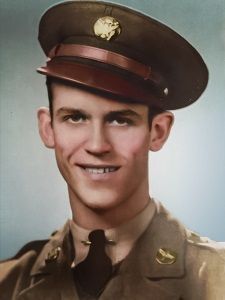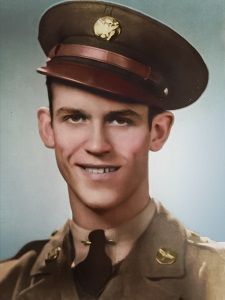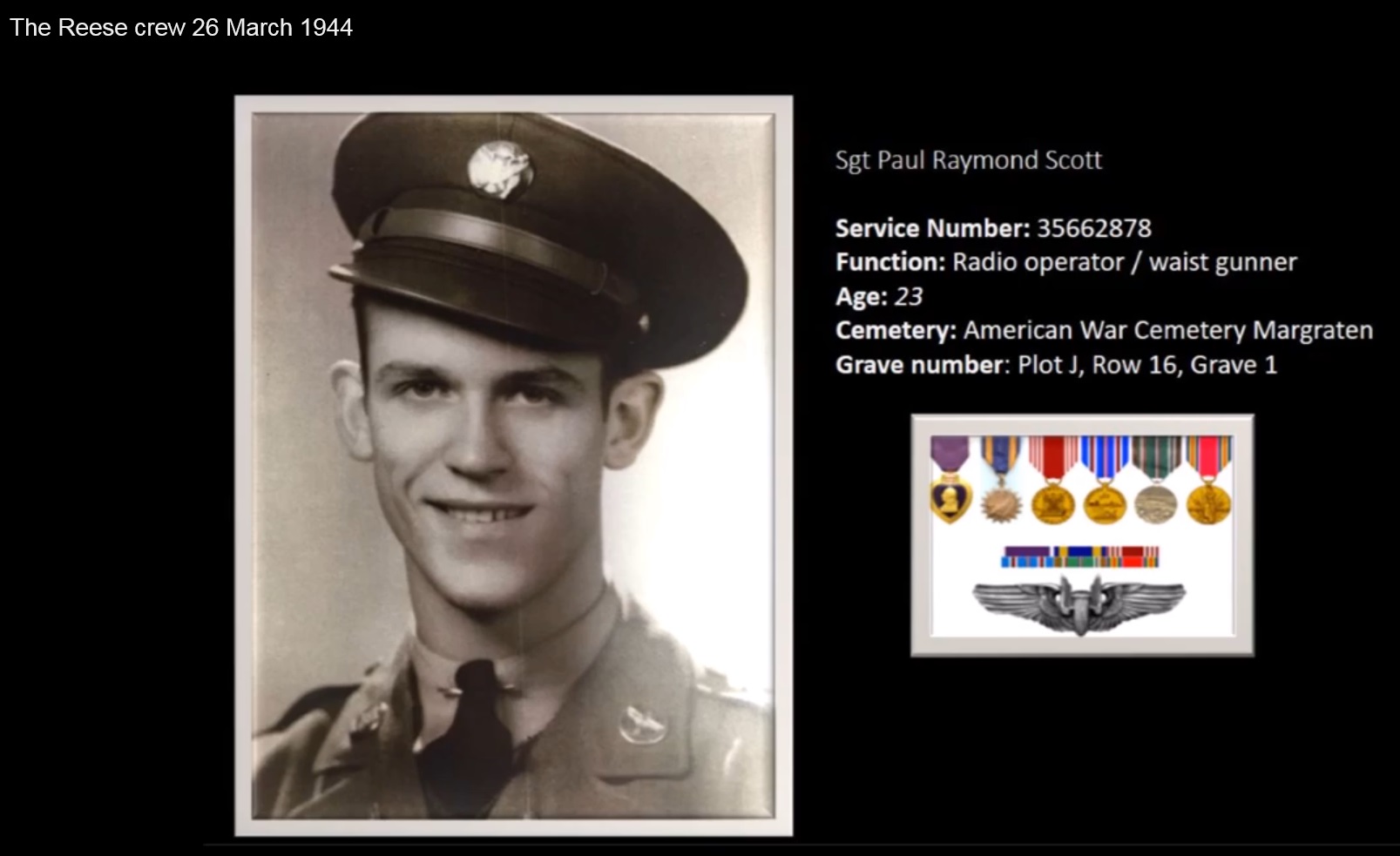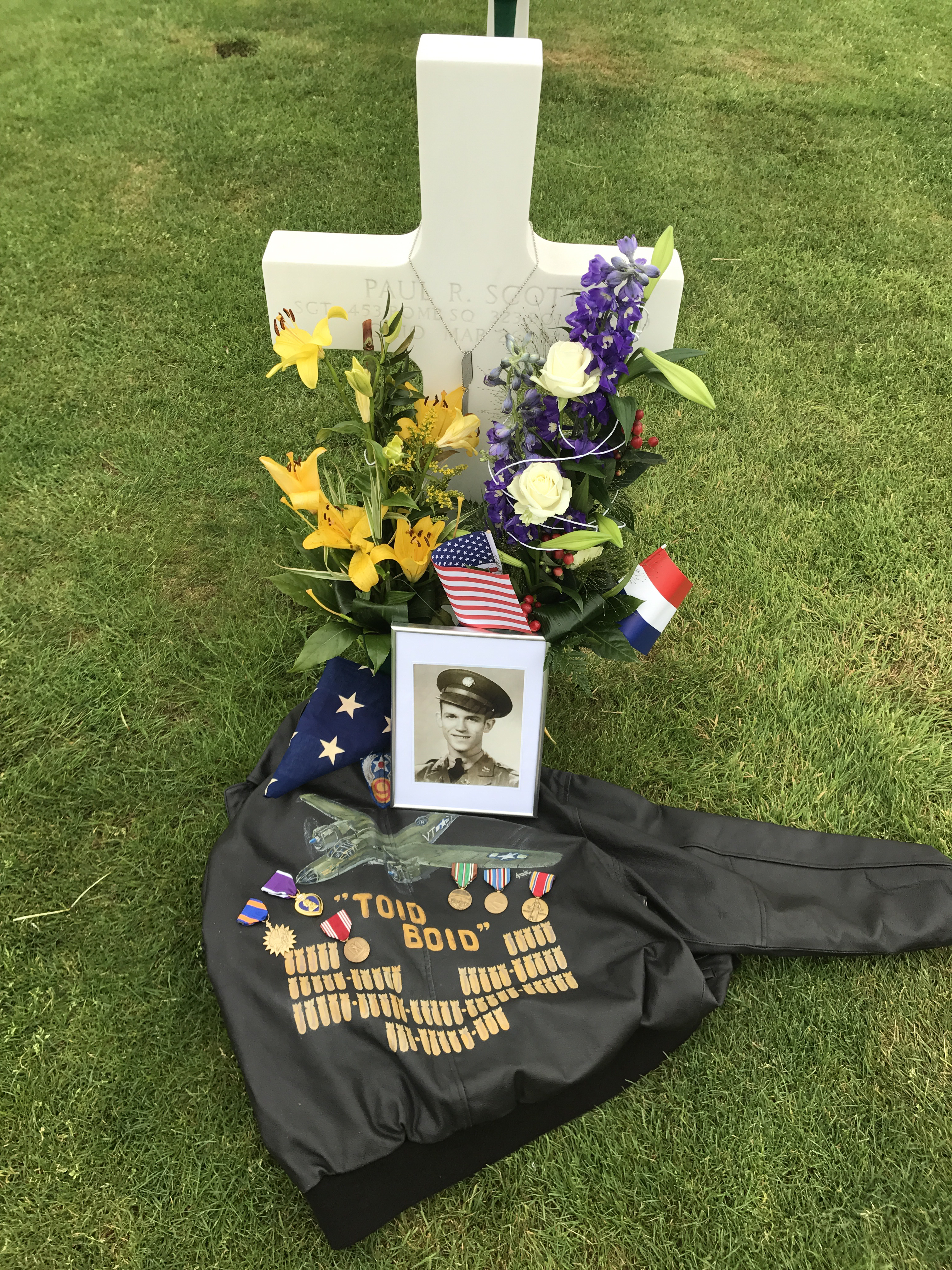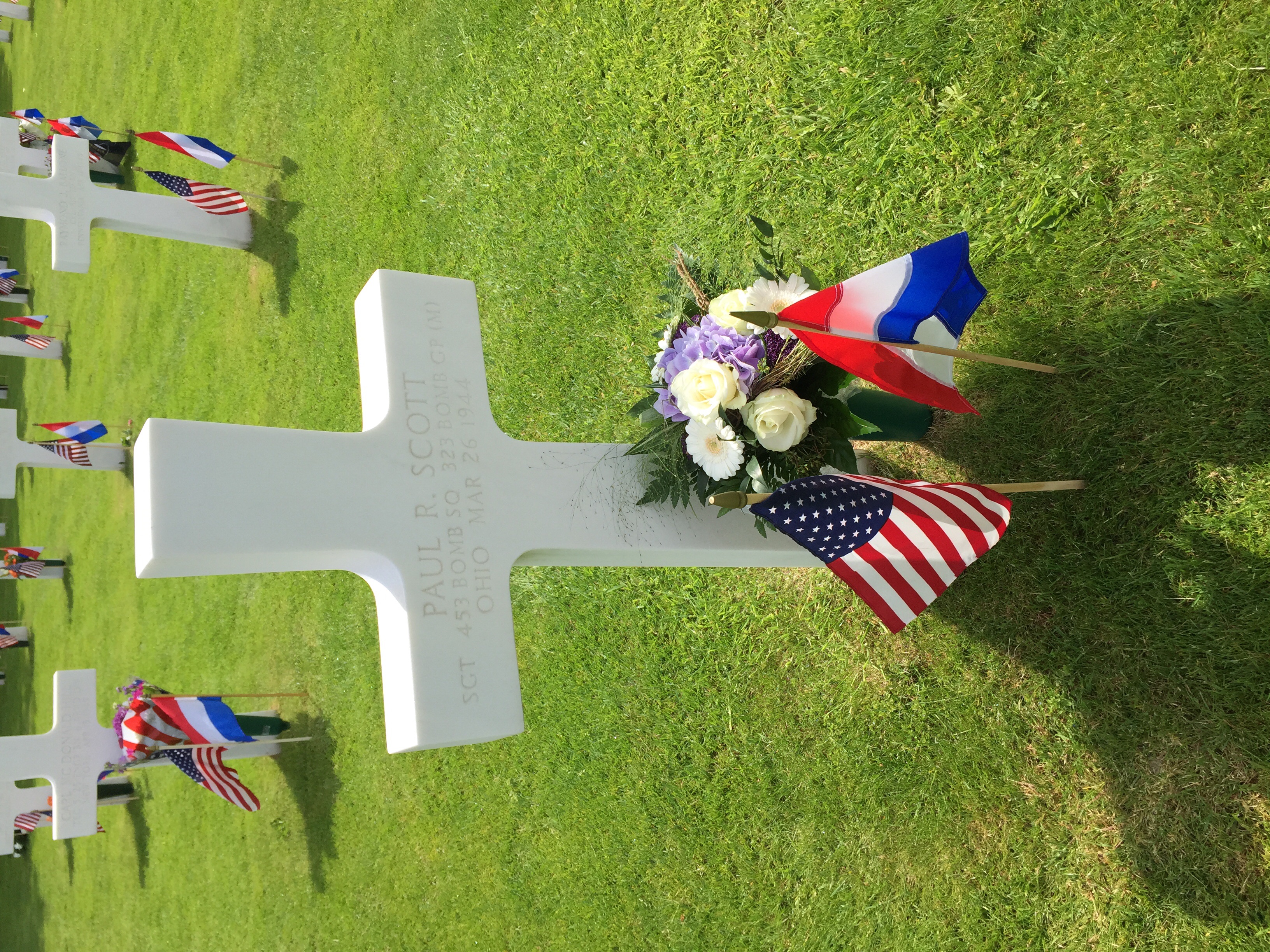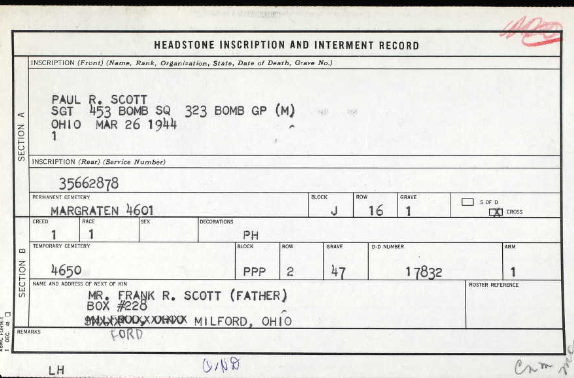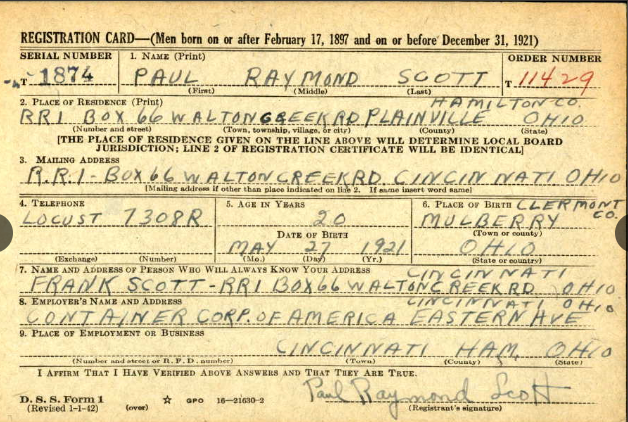Sgt. Scott, a graduate of Milford High School and a former employee of the Container Corporation of America, had been over seas for six months. A brother, Aviation Cadet Woodrow Scott,is completing bombardier training with the Army Air Forces on the West Coast.
------------
Entered the service from Ohio.
------------
IJmuiden ... For the United States air force was this place synonymous with extremely high losses. It was almost one year before, on May 14, 1943, that the two-engine Marauders of the United States air force hat their first operational mission over occupied Northwest Europe carried out. The goal was the electricity plant in Velsen. Several bombs struck the goal, but electricity plant was not disabled. So that 3 days later they attacked again. This second mission was a drama. From the eleven ascended Marauders returned one early, while the other ten not returned. Because this big loss, the Marauder was nicknamed the Widow Maker. This was not good for the moral of the new American crews.
IJmuiden was of strategic importance. The reasons were the presence of the blast furnaces, the electrical-Central, the great sea lock, the direct route to Amsterdam and of course the port itself which was used by the German Navy (kriegsmarine).
Minesweepers, speedboats (Schnellboten) were regular in the port. The speedboats laid mines in the Allied shipping routes and attacked them with their torpedos. For the allies formed these boats a threat, because during the fighting at sea they were hard to intercept by their speed. So it was easier to destroy the location of these ships.
In mid-November 1941 the germans finished there first speed boot bunker 1 Schnellbootbunker 1 at the haringhaven port. This bunker offered protection against bombing for ten boats . Early 1943 began the construction of a second bunker at the haringhavenport. This bunker offered shelters for fourteen boats and also had four repair docks. This construction works was of enormous size. The second bunker had a roof that was to 4.75 m thick. The length was more than 240 metres and the height almost 18 metres. Sunday 26 March 1944 a beautiful and warm day with clear weather. In England prevailed in many airports of the Royal Air Force and United States Army Air Force 9th great activity. The goal were the two large bunkers in the haringshaven. Sgt Paul Raymond Scott and his crew the Reese Crew will participate in this action with their B26 Marauder the toid Boid. Around noon the heavily loaded bombers direct course to the target. Along the way they got escort of British fighter aircraft, which had to fend off possible German fighters.
To 12.55 hour sounds at the city of Velsen the air alarm. This alarm was for a short time, because at 13.02 o'clock came the signal end alarm. The German anti-aircraft guns, that around IJmuiden was drafted, did not come into action. It was not long before the second air alarm followed at 13.27 hours. Also in Amsterdam, air alarm sounded. The national championship game between the football clubs Volewijckers and Heerenveen was only running for eleven minutes. The players rushed to the dressing rooms, while the audience remained seated in the stadium. Several times, the audience was asked to clear the stands, until the Mayor of Amsterdam decided to cancel this important game.
At 13:30 the medium bombers of the 2 Group RAF bombed first. On the front there are flew twenty-six Mitchells, followed by eighteen Boston. The attack came from the Sun from South west direction. The German air defense, who starting from 13.21 hours in highest State of preparedness were, came into action. The RAF crews reported on their return that the German shooters literally had cried out because they had given the RAF a very warm welcome.
Under the Mitchells was the Dutch 320 Squadron. The ground staff had described the 1000 pounders with applicable cries like we are soon being back home and Mother can you hear me?.
The commander of the Dutch squadron heart at that time, a blow which significantly louder than the last. Our plane was shaking. Right, steady, steady, bombing, bombing, goooo!. He shouted relieved by his microphone, while the bombardier pressed his firing button.
Afterwards the bombardier Bomb hits were observed to the Northwest of the target area, as well as hits running from west to East North-East of the target area. Bomb hits were also observed between buildings and the area between the ports, while burning and explosions were seen with probable hits on the target. He describes that the enemy air defenses were moderate to intense, the air defense started just before reaching the target area and the formation remained until approximately eight kilometers off the coast.
The ninth U.s. air force pulled with a gigantic armada to IJmuiden. As many as 378 Marauders of seven Bomb Groups had been ordered to attack the bunkers this was a new record. A total of 344 Marauders take off. The first attack wave bombarded with 140 aircraft between 14.17 and 16.39 h. Number 322 Bomb Group, which in May 1943 had carried out the attacks on IJmuiden, leading with Lieutenant Colonel Gove Celio the attack wave. A total of 21 first mission veterans participated in this attack. The second attack wave with 198 appliances was around quarter to three finished with bombing. More than 1300 firebombs whizzed down "and take unprecedented revenge after the dramatic experiences in May 1943.
The German air defenses was unable to repel the attack. The Germans reported that fifteen bombers showed a black plume. Five would be shot. In reality one Marauder did get a a direct hit around 14.49 hours (this was the Toid Boid).
Eyewitnesses saw that the unit at the bomb Bay was hit and exploded. The Reese crew of number 323 Bomb Group collapsed in the dunes of IJmuiden at IJmuiderslag". The six-member crew did not survive.
Statement from Sgt Robert C. Malarkey, Tail Gunner, A/C 787:
"While we were on the bomb run, I saw Lt. Reese's airplane on fire. The fire was coming from the roots of the wings and was streaming back to the tail. We turned and I lost sight of it momentarily. The next time I saw it, it was spiraling steeply down. I saw it strike on the coast and explode. I did not see any chutes from the airplane.
The German report indicates that "Toid Boid" was shot down by heavy flack at 14.44 hrs local time and crashed 2 km south of IJmuiden in the Dunes.
The crew of the Toid Boid was a new crew because the actual crew (Foster crew) had a day off. The crew on this day was called the "Reese crew", concerning the following crew-members:
* 2nd Lt Halmyth C. Reese (Pilot),
* Major William C. Berryman (Co Pilot),
* Sgt Paul R. Scott (Radio operator/ Waist gunner)
* Sgt Ralph R. Brown (Bombardier),
* S/Sgt Alex E. Sundberg (Armorer/Turret gunner)
* Sgt Donald L. Jacobs (Engineer/Tail gunner)
Investigation at the crash site learned that the wreckage was destroyed for 95%. Only a part of the tail was recognizable, filed with number 134 on the left side and 853 on the right side. 5 crewmembers where be identified but the body of Sgt Paul Raymond Scott was found among the back dome, at that time he could not be identified. The crew was buried on March 29, 1944 in IJmuiden on the cemetery at the Havenkade and transferred after the war to Margraten at Temporary American Military Cemetery at Margraten in 3 cases repatriated to the USA. At 1948 1949 many soldiers were repatriated to the USA. In this time Sgt Scott reburied in to his final resting place at American Military Cemetery Magraten Plot J, Row 16, Grave 1. For his sacrifice/service and has contributed to our freedom, he got a purple heart.
wo Marauders made an emergency landing on British bases-the crews remained unharmed. Below was the unit of Lieutenant Colonel Gove Celio, who with his Johnny Zero on Framlingham made an emergency landing and the plane was damaged to the ground. Due to the heavy air defenses were over 80 Marauders damaged "a damage rate of 22%.
Despite the many off bombs were the results of the attack disappointing. The German Commander Festungskommandant of IJmuiden, Oberst Peters, reported only nine critical hits on existing bunker. This was very slightly damaged. The cement was damaged to a depth of 15 cm. The new bunker also got some hits, without serious damage. Oberst Peters proudly reported that the completion of the bunker not delayed. A lot ofe bombs fell outside the target area. The entire dune area west and South of the herring port was covered with bomb craters. The allies were instructed to do everything possible to save the commune; most bombs fell too early.
In Old-IJmuiden were many critical hits at the Northern quay (the reformed church), Prins hendrikstraat, channel and Anna Street. On the South side of the fishing port were critical hits in the Trawler Wharf, the Middenhavenstraat, industriestraat, herring Quay and Logger Street.
Holes of five meters deep and 10 meters in diameter were beaten in the streets. Because the whole area was evacuated and it was a Sunday, so there were very few people in the industrial district, the number of civilian casualties in proportion to the size of the bombardment. Eight civilians were killed; five of them by a direct hit on a shelter on the corner of Quay Street and herring the Logger.
The Germans counted 17 dead, 24 missing and 36 injured. In the port, four port security boats Hafenschutzboten were destroyed, one floating Torpedo boat was detroyed and one patrol boat Vorpostenboot was lost, while one security boat Hafenschutzboot was damaged. Two speed boats Schnellboten stood outside the bunkers. By critical hits on board torpedos exploded so that it sank. A cold store at the Trawler Wharf got a direct hit. This cool House was used for store meat, fruits and vegetables. Part of the stored food and beverages was lost. In the cellars of fish hall A there were explosives stored so that at a possible Allied landing the port could be destroyed. The fish hall was hit and caught fire.
By put out this fire in a short time it could be prevented that the stored explosives did explode.
In London concluded that the attack on the bunkers came two months to late. Since the beginning of 1943 were the claims of bunker 2 were followed. At the end of January 1944, started with the concrete roof over the moorings. A successful bombardment at that time probably caused heavy damage or delayed the delivery. On March 26, the roof was ready and could stand the 1000 pounders, which these huge construction work, there was no serious damage. The attack was anything but a success, a waste of time, energy, material and human lives.
Source: World War II Investigations Family Scott
Sgt. Scott, a graduate of Milford High School and a former employee of the Container Corporation of America, had been over seas for six months. A brother, Aviation Cadet Woodrow Scott,is completing bombardier training with the Army Air Forces on the West Coast.
------------
Entered the service from Ohio.
------------
IJmuiden ... For the United States air force was this place synonymous with extremely high losses. It was almost one year before, on May 14, 1943, that the two-engine Marauders of the United States air force hat their first operational mission over occupied Northwest Europe carried out. The goal was the electricity plant in Velsen. Several bombs struck the goal, but electricity plant was not disabled. So that 3 days later they attacked again. This second mission was a drama. From the eleven ascended Marauders returned one early, while the other ten not returned. Because this big loss, the Marauder was nicknamed the Widow Maker. This was not good for the moral of the new American crews.
IJmuiden was of strategic importance. The reasons were the presence of the blast furnaces, the electrical-Central, the great sea lock, the direct route to Amsterdam and of course the port itself which was used by the German Navy (kriegsmarine).
Minesweepers, speedboats (Schnellboten) were regular in the port. The speedboats laid mines in the Allied shipping routes and attacked them with their torpedos. For the allies formed these boats a threat, because during the fighting at sea they were hard to intercept by their speed. So it was easier to destroy the location of these ships.
In mid-November 1941 the germans finished there first speed boot bunker 1 Schnellbootbunker 1 at the haringhaven port. This bunker offered protection against bombing for ten boats . Early 1943 began the construction of a second bunker at the haringhavenport. This bunker offered shelters for fourteen boats and also had four repair docks. This construction works was of enormous size. The second bunker had a roof that was to 4.75 m thick. The length was more than 240 metres and the height almost 18 metres. Sunday 26 March 1944 a beautiful and warm day with clear weather. In England prevailed in many airports of the Royal Air Force and United States Army Air Force 9th great activity. The goal were the two large bunkers in the haringshaven. Sgt Paul Raymond Scott and his crew the Reese Crew will participate in this action with their B26 Marauder the toid Boid. Around noon the heavily loaded bombers direct course to the target. Along the way they got escort of British fighter aircraft, which had to fend off possible German fighters.
To 12.55 hour sounds at the city of Velsen the air alarm. This alarm was for a short time, because at 13.02 o'clock came the signal end alarm. The German anti-aircraft guns, that around IJmuiden was drafted, did not come into action. It was not long before the second air alarm followed at 13.27 hours. Also in Amsterdam, air alarm sounded. The national championship game between the football clubs Volewijckers and Heerenveen was only running for eleven minutes. The players rushed to the dressing rooms, while the audience remained seated in the stadium. Several times, the audience was asked to clear the stands, until the Mayor of Amsterdam decided to cancel this important game.
At 13:30 the medium bombers of the 2 Group RAF bombed first. On the front there are flew twenty-six Mitchells, followed by eighteen Boston. The attack came from the Sun from South west direction. The German air defense, who starting from 13.21 hours in highest State of preparedness were, came into action. The RAF crews reported on their return that the German shooters literally had cried out because they had given the RAF a very warm welcome.
Under the Mitchells was the Dutch 320 Squadron. The ground staff had described the 1000 pounders with applicable cries like we are soon being back home and Mother can you hear me?.
The commander of the Dutch squadron heart at that time, a blow which significantly louder than the last. Our plane was shaking. Right, steady, steady, bombing, bombing, goooo!. He shouted relieved by his microphone, while the bombardier pressed his firing button.
Afterwards the bombardier Bomb hits were observed to the Northwest of the target area, as well as hits running from west to East North-East of the target area. Bomb hits were also observed between buildings and the area between the ports, while burning and explosions were seen with probable hits on the target. He describes that the enemy air defenses were moderate to intense, the air defense started just before reaching the target area and the formation remained until approximately eight kilometers off the coast.
The ninth U.s. air force pulled with a gigantic armada to IJmuiden. As many as 378 Marauders of seven Bomb Groups had been ordered to attack the bunkers this was a new record. A total of 344 Marauders take off. The first attack wave bombarded with 140 aircraft between 14.17 and 16.39 h. Number 322 Bomb Group, which in May 1943 had carried out the attacks on IJmuiden, leading with Lieutenant Colonel Gove Celio the attack wave. A total of 21 first mission veterans participated in this attack. The second attack wave with 198 appliances was around quarter to three finished with bombing. More than 1300 firebombs whizzed down "and take unprecedented revenge after the dramatic experiences in May 1943.
The German air defenses was unable to repel the attack. The Germans reported that fifteen bombers showed a black plume. Five would be shot. In reality one Marauder did get a a direct hit around 14.49 hours (this was the Toid Boid).
Eyewitnesses saw that the unit at the bomb Bay was hit and exploded. The Reese crew of number 323 Bomb Group collapsed in the dunes of IJmuiden at IJmuiderslag". The six-member crew did not survive.
Statement from Sgt Robert C. Malarkey, Tail Gunner, A/C 787:
"While we were on the bomb run, I saw Lt. Reese's airplane on fire. The fire was coming from the roots of the wings and was streaming back to the tail. We turned and I lost sight of it momentarily. The next time I saw it, it was spiraling steeply down. I saw it strike on the coast and explode. I did not see any chutes from the airplane.
The German report indicates that "Toid Boid" was shot down by heavy flack at 14.44 hrs local time and crashed 2 km south of IJmuiden in the Dunes.
The crew of the Toid Boid was a new crew because the actual crew (Foster crew) had a day off. The crew on this day was called the "Reese crew", concerning the following crew-members:
* 2nd Lt Halmyth C. Reese (Pilot),
* Major William C. Berryman (Co Pilot),
* Sgt Paul R. Scott (Radio operator/ Waist gunner)
* Sgt Ralph R. Brown (Bombardier),
* S/Sgt Alex E. Sundberg (Armorer/Turret gunner)
* Sgt Donald L. Jacobs (Engineer/Tail gunner)
Investigation at the crash site learned that the wreckage was destroyed for 95%. Only a part of the tail was recognizable, filed with number 134 on the left side and 853 on the right side. 5 crewmembers where be identified but the body of Sgt Paul Raymond Scott was found among the back dome, at that time he could not be identified. The crew was buried on March 29, 1944 in IJmuiden on the cemetery at the Havenkade and transferred after the war to Margraten at Temporary American Military Cemetery at Margraten in 3 cases repatriated to the USA. At 1948 1949 many soldiers were repatriated to the USA. In this time Sgt Scott reburied in to his final resting place at American Military Cemetery Magraten Plot J, Row 16, Grave 1. For his sacrifice/service and has contributed to our freedom, he got a purple heart.
wo Marauders made an emergency landing on British bases-the crews remained unharmed. Below was the unit of Lieutenant Colonel Gove Celio, who with his Johnny Zero on Framlingham made an emergency landing and the plane was damaged to the ground. Due to the heavy air defenses were over 80 Marauders damaged "a damage rate of 22%.
Despite the many off bombs were the results of the attack disappointing. The German Commander Festungskommandant of IJmuiden, Oberst Peters, reported only nine critical hits on existing bunker. This was very slightly damaged. The cement was damaged to a depth of 15 cm. The new bunker also got some hits, without serious damage. Oberst Peters proudly reported that the completion of the bunker not delayed. A lot ofe bombs fell outside the target area. The entire dune area west and South of the herring port was covered with bomb craters. The allies were instructed to do everything possible to save the commune; most bombs fell too early.
In Old-IJmuiden were many critical hits at the Northern quay (the reformed church), Prins hendrikstraat, channel and Anna Street. On the South side of the fishing port were critical hits in the Trawler Wharf, the Middenhavenstraat, industriestraat, herring Quay and Logger Street.
Holes of five meters deep and 10 meters in diameter were beaten in the streets. Because the whole area was evacuated and it was a Sunday, so there were very few people in the industrial district, the number of civilian casualties in proportion to the size of the bombardment. Eight civilians were killed; five of them by a direct hit on a shelter on the corner of Quay Street and herring the Logger.
The Germans counted 17 dead, 24 missing and 36 injured. In the port, four port security boats Hafenschutzboten were destroyed, one floating Torpedo boat was detroyed and one patrol boat Vorpostenboot was lost, while one security boat Hafenschutzboot was damaged. Two speed boats Schnellboten stood outside the bunkers. By critical hits on board torpedos exploded so that it sank. A cold store at the Trawler Wharf got a direct hit. This cool House was used for store meat, fruits and vegetables. Part of the stored food and beverages was lost. In the cellars of fish hall A there were explosives stored so that at a possible Allied landing the port could be destroyed. The fish hall was hit and caught fire.
By put out this fire in a short time it could be prevented that the stored explosives did explode.
In London concluded that the attack on the bunkers came two months to late. Since the beginning of 1943 were the claims of bunker 2 were followed. At the end of January 1944, started with the concrete roof over the moorings. A successful bombardment at that time probably caused heavy damage or delayed the delivery. On March 26, the roof was ready and could stand the 1000 pounders, which these huge construction work, there was no serious damage. The attack was anything but a success, a waste of time, energy, material and human lives.
Source: World War II Investigations Family Scott
Family Members
Sponsored by Ancestry
Advertisement
Explore more
Sponsored by Ancestry
Advertisement
